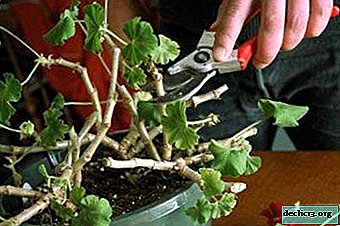What kind of plant is rhododendron bloombux micranthum (blumbux mikrantum) and how to care for it?

The Blumbox hybrid rhododendron is a novelty of modern hybridization.
It features an unprecedented density of a compact crown and special adaptability even in neutral soils.
The plant has several species. In the article we will consider in more detail the Bloombox sub-variety, talk about the features of caring for this type of shrub, and also reveal the issue of preventing various problems.
A brief definition of this type
Rhododendron Blumbux belongs to a hybrid variety of undersized rhododendrons of the Heather family. These varieties are the results of recent experiments on the selection of dwarf azaleas. Hybrid varieties bred in Germany.
Detailed description
An evergreen shrub of small stature, the height of an adult bush reaches 1 m. The crown is dense, sprawling, extends up to 1 m in width. Branches grow well and branch. Blumbux variety has small, narrow leaves, up to 4 - 5 cm in length, oblong.
It blooms in June, blooms for a long time, about 4 weeks. The flowers are white - pink, petals are wavy, bell-shaped or cup-shaped in shape, with a diameter of 5 - 6 cm (what are the colors of azaleas?)
A frost-resistant variety, with proper care, mulching and shelter for the winter, it winters well. The root is flat, located shallow.History of occurrence
The first varieties of Rhododendron Blumbux were bred by German breeders in 2000. A hybrid exot bloombux rhododendron micranthum was produced by crossing dwarf species of rhododendrons hirsutum and micranthum. This variety has been licensed and widely available in Germany in the fall of 2014.
What is the difference from the rest of the species?
Rhododendron Blumbux Mikrantum leaves spicy scent when wiped. This variety is unpretentious in the choice of substrate - it perfectly develops in neutral, moderately acidic soil. You can find out about all types of azaleas in a separate article.
Subsort Bloombux and their photos
Micranthum

The bush is evergreen, dwarf, low, grows 40 - 50 cm in height. The crown is round, compact, dense, lends itself well to pruning. The leaves are small, spiky, oblong, dense in structure, bright green.
The flowers are densely planted on the stems, during the abundant flowering of inflorescences form a ball, the leaves are almost invisible. Frost resistance is average, the variety can tolerate frosts up to - 23 ° C.
Important! The variety is an exclusive novelty of hybrid rhododendrons.Inkarno

Evergreen bush, stunted, height of an adult 10-year-old bush 60 - 75 cm. Blooms in June with fragrant white - pink stars. Pointed petals. Calyx flower, medium in size, up to 6 cm in diameter.
The leaves are concave, glossy, elongated. Separated by a longitudinal vein, bright green, medium, 7 cm long, 3-4 cm wide. Frost resistance is moderate, the variety withstands frosts down to -20 ° C. It is prone to pruning to form a beautiful bush.
Germania Inkarno

Evergreen bush 1.5 - 1.7 m high. The crown is dense, dense. It blooms in May, duration - 2 - 3 weeks. The flowers are pale pink at the edges, inside the calyx, the flower is pale pink with a dark scattering of spots. The flowers are medium in size, 6 cm in diameter, the petals are rounded, wavy at the edges. The leaves are large, lobed, blunt, pale green. Frost resistance is sufficient, the optimum temperature in the winter season is up to -20 °.
Bloom
When and how?
Flowering begins in June after the appearance of bright green leaves. Small, densely planted flowers form a dense crown - a soft pink coverlet. Long flowering - 2 to 3 weeks.
REFERENCE! Even young bushes are distinguished by annual, generous flowering.You can read about the richness of colors and shades of azalea in this article.
Features
Rhododendron Blumbux should be replanted before flowering, in April - May, when the soil warms up. For this variety, cool temperatures are desirable, especially before flowering, at the time of flower ripening. Immediately after flowering, it is desirable to prune dry flowers.
What if there are no buds?
Perhaps rhododendron does not bloom due to a lack of minerals in the soil, fertilizing with superphosphate or complex liquid fertilizers for azaleas is necessary. You should look at branches and leaves, fungal lesions or the presence of ticks are possible.
Care
Choosing a place for a flower
 This species is considered a particularly hardy variety. With good moisture and light shading in the afternoon, it can grow in the sun. The most optimal landing site is partial shade, diffused light under the canopy of other, higher bushes of evergreen thuja and cypress trees.
This species is considered a particularly hardy variety. With good moisture and light shading in the afternoon, it can grow in the sun. The most optimal landing site is partial shade, diffused light under the canopy of other, higher bushes of evergreen thuja and cypress trees.
What should be the soil?
The substrate should be loose, breathable and drained.
The composition of the substrate for the variety Blumbux:
 Horse peat.
Horse peat.- Coniferous or leafy land.
- Sand.
- Ratio: 2: 2: 2.
- Perlite to retain moisture.
- Drainage layer - pebbles, gravel, pieces of bark.
Landing
 Rhododendron Blumbux tolerates even calcareous and neutral soils. Rhododendron Blumbux is tolerated in early spring, you can plant bushes after flowering, in September - October.
Rhododendron Blumbux tolerates even calcareous and neutral soils. Rhododendron Blumbux is tolerated in early spring, you can plant bushes after flowering, in September - October.
The planting procedure is simple, performed sequentially:
- They dig a landing hole, it should be 2 times larger than the root, about 40 - 50 cm deep, 50 - 60 cm wide.
- A drainage layer of 10-15 cm is laid at the bottom.
- Half of the special substrate is poured with a slide.
- Vertically place the bush in a pit, spread the roots, gently press the soil in a circle.
- The root is not buried.
- Fall asleep with the remaining substrate to the level of the root neck, slightly tamping the soil.
- Abundant and regular watering is required.
- Mulch with a mixture of foliage, needles and sawdust, a layer of 5 - 6 cm.
We also recommend watching a video on how to properly plant this type of plant:
Temperature
 In winter, Rhododendron Blumbux withstands frosts up to - 23 -25C. The optimum temperature for the development and ripening of buds is 12 - 14 ° C.
In winter, Rhododendron Blumbux withstands frosts up to - 23 -25C. The optimum temperature for the development and ripening of buds is 12 - 14 ° C.
In hot weather with regular heavy watering and showers, this hardy variety can tolerate temperatures of 25 - 30 ° C.
Watering
 In summer, daily plentiful watering is required. The substrate around the bush should get wet to a depth of at least 15 cm. Excessive watering is also undesirable for the Blumbux rhododendron, as well as overdrying. In summer, daily irrigation of the bushes in the early morning or after sunset is recommended. Before frosts, bushes are well watered, saturating the roots with moisture. In winter and autumn, water should be watered as the soil dries.
In summer, daily plentiful watering is required. The substrate around the bush should get wet to a depth of at least 15 cm. Excessive watering is also undesirable for the Blumbux rhododendron, as well as overdrying. In summer, daily irrigation of the bushes in the early morning or after sunset is recommended. Before frosts, bushes are well watered, saturating the roots with moisture. In winter and autumn, water should be watered as the soil dries.
For irrigation use rain, settled water, calculated at 8 - 9 liters per adult bush.
Top dressing
 The soil should be rich in humus and organic fertilizers - compost. After planting, fertilize with amygdine to strengthen the young seedling. To enrich the soil 1 - 2 times a month add peat. So that the leaves do not turn yellow, the flowers are fed with a solution of iron chelate.
The soil should be rich in humus and organic fertilizers - compost. After planting, fertilize with amygdine to strengthen the young seedling. To enrich the soil 1 - 2 times a month add peat. So that the leaves do not turn yellow, the flowers are fed with a solution of iron chelate.
For young seedlings, the doses of top dressing should be gentle, reduced.
Pruning
 This plant tolerates a haircut. You can give the crown a rounded or square shape. A feature of the hardy variety - after pruning, the bushes retain bright greenery, do not get sick. It is also advisable to cut out excess basal shoots.
This plant tolerates a haircut. You can give the crown a rounded or square shape. A feature of the hardy variety - after pruning, the bushes retain bright greenery, do not get sick. It is also advisable to cut out excess basal shoots.
Trimming bushes is possible only after floweringso as not to damage the flower buds.
Transfer
 Transplanted bushes after flowering, after 2 to 3 weeks, or in early spring, in March.
Transplanted bushes after flowering, after 2 to 3 weeks, or in early spring, in March.
In the first year after transplanting, it is better to cut out all the buds, flowering can weaken the fragile root of the transplanted bush.
In snowless winters in cold climates, mulching is required and shelter for the winter bushes with coniferous branches or burlap.
Mulch is updated every spring around the base with a layer of 5 - 7 cm.
Breeding
Propagated by layering or cuttings.Propagation by cuttings is carried out in July - August:
- Cuttings of 6 - 7 cm are cut.
- Planting processes are soaked for 12 hours in a solution of a growth stimulator.
- Cuttings are planted in small boxes in a sand - peat mixture, covered with a film or glass.
- Aeration of greenhouses regularly - 2 - 3 times a day.
- After 4 weeks, the cuttings will take root.
- In autumn, seedlings are transferred to the cellar, where they grow up until next spring.
- The grown seedlings are planted in open ground in the garden or in large boxes.
Reproduction by layering is a simple procedure that does not require much effort:
- Choose a branch that grows low to the ground.
- An incision is made on the stem.
- Lay the branch in a small hole, fix it with hooks from the wire, and add it.
- When the shoot takes root, the bush is separated.
Diseases and Pests
 A mealybug, a rhododendral bug and a weevil can attack the Rhododendron Blumbux. Timely spraying with insecticides is necessary - actar or phytoerm. If the damage is strong, the treatment is repeated after 10 days.
A mealybug, a rhododendral bug and a weevil can attack the Rhododendron Blumbux. Timely spraying with insecticides is necessary - actar or phytoerm. If the damage is strong, the treatment is repeated after 10 days.- They attack bushes and garden snails and slugs, they are usually collected manually.
- A soap solution will help get rid of the spider mite. It can be sprayed with a fungicide solution. Usually, a single treatment is sufficient to kill the pest.
Prevention of various problems
- Problems usually arise from dampness, waterlogging of the soil, improper doses of fertilizers or fungal diseases.
- Due to the sun or insufficient watering, leaves and stems may turn brown - watering needs to be adjusted.
- Damaged leaves should be collected, diseased stems cut, sometimes, when the flowers are completely infected, culling of the bush is required. By collecting and burning damaged foliage, performing sanitary pruning and treating plants with fungicides, many diseases and problems can be avoided.
For the prevention of diseases and the appearance of pests, it is necessary to treat the bushes with Bordeaux liquid in late autumn and early spring , before the appearance of bees and insects - pollinators.
Rhododendron Blumbux - an exclusive series of unpretentious and hardy exotic flower has become widespread among amateur gardeners.

 Horse peat.
Horse peat. A mealybug, a rhododendral bug and a weevil can attack the Rhododendron Blumbux. Timely spraying with insecticides is necessary - actar or phytoerm. If the damage is strong, the treatment is repeated after 10 days.
A mealybug, a rhododendral bug and a weevil can attack the Rhododendron Blumbux. Timely spraying with insecticides is necessary - actar or phytoerm. If the damage is strong, the treatment is repeated after 10 days.















